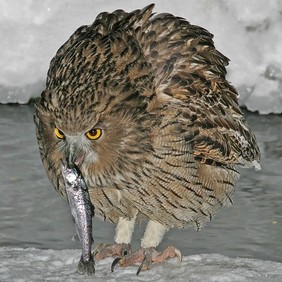A study spearheaded by the Wildlife Conservation Society and the University
of Minnesota has shown that the world's largest owl — and one of the rarest — is
also a key indicator of the health of some of the last great primary forests of
Russia's Far East.
The study found that the rare and spectacular Blakiston's Fish Owl relies on old-growth forests
along streams for both breeding and to support healthy populations of their
favourite prey: salmon. The large trees provide breeding cavities for the
enormous bird, which has a two-metre (6ft) wingspan. And when these dead,
massive trees topple into adjacent streams, they disrupt water flow, forcing the
gushing river around, over, and under these new obstacles. The result is stream
channel complexity: a combination of deep, slow-moving backwaters and shallow,
fast-moving channels that provide important micro-habitats critical to salmon in
different developmental stages.
The study appears in the October issue of the journal Oryx and is
currently available online as a
PDF. The authors, including Jonathan Slaght of the Wildlife
Conservation Society, R. J. Gutiérrez of the University of Minnesota, and Sergei
Surmach of the Institute of Biology and Soils (Russian Academy of Sciences),
studied the foraging and nesting characteristics of Blakiston's Fish Owl in
Primorye, Russia, where they looked at nesting habitat over 20,213 square
kilometres (7,804 square miles). They found that large old trees and riparian
old-growth forest were the primary distinguishing characteristics of both nest
and foraging sites.
The authors say that management and conservation of old-growth forests is
essential for sustaining this species because they are central to the owls'
nesting and foraging behaviour. Moreover, conservation of Primorye's forests and
rivers sustains habitat for many other species, including eight salmon and trout
species that spawn there; some of the 12 other owl species found in Primorye;
and mammals such as the endangered Amur (or Siberian) Tiger, Asiatic Black Bear, and Wild Boar. Listed as Endangered by IUCN, Blakiston's Fish Owl is restricted to riparian areas in Russia, China, Japan and possibly North Korea.
"Blakiston's Fish Owl is a clear indicator of the health of the forests,
rivers, and salmon populations," said lead author Jonathan Slaght. "Retention of
habitat for fish owls will also maintain habitat for many other species
associated with riparian old-growth forests in the Russian Far East."
of Minnesota has shown that the world's largest owl — and one of the rarest — is
also a key indicator of the health of some of the last great primary forests of
Russia's Far East.
The study found that the rare and spectacular Blakiston's Fish Owl relies on old-growth forests
along streams for both breeding and to support healthy populations of their
favourite prey: salmon. The large trees provide breeding cavities for the
enormous bird, which has a two-metre (6ft) wingspan. And when these dead,
massive trees topple into adjacent streams, they disrupt water flow, forcing the
gushing river around, over, and under these new obstacles. The result is stream
channel complexity: a combination of deep, slow-moving backwaters and shallow,
fast-moving channels that provide important micro-habitats critical to salmon in
different developmental stages.
The study appears in the October issue of the journal Oryx and is
currently available online as a
PDF. The authors, including Jonathan Slaght of the Wildlife
Conservation Society, R. J. Gutiérrez of the University of Minnesota, and Sergei
Surmach of the Institute of Biology and Soils (Russian Academy of Sciences),
studied the foraging and nesting characteristics of Blakiston's Fish Owl in
Primorye, Russia, where they looked at nesting habitat over 20,213 square
kilometres (7,804 square miles). They found that large old trees and riparian
old-growth forest were the primary distinguishing characteristics of both nest
and foraging sites.
The authors say that management and conservation of old-growth forests is
essential for sustaining this species because they are central to the owls'
nesting and foraging behaviour. Moreover, conservation of Primorye's forests and
rivers sustains habitat for many other species, including eight salmon and trout
species that spawn there; some of the 12 other owl species found in Primorye;
and mammals such as the endangered Amur (or Siberian) Tiger, Asiatic Black Bear, and Wild Boar. Listed as Endangered by IUCN, Blakiston's Fish Owl is restricted to riparian areas in Russia, China, Japan and possibly North Korea.
"Blakiston's Fish Owl is a clear indicator of the health of the forests,
rivers, and salmon populations," said lead author Jonathan Slaght. "Retention of
habitat for fish owls will also maintain habitat for many other species
associated with riparian old-growth forests in the Russian Far East."



 RSS Feed
RSS Feed